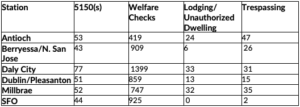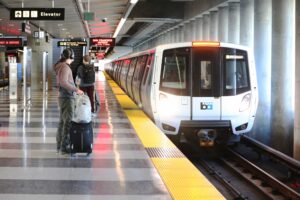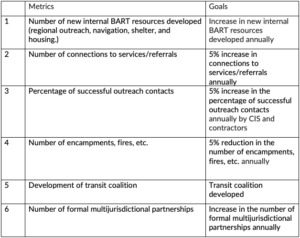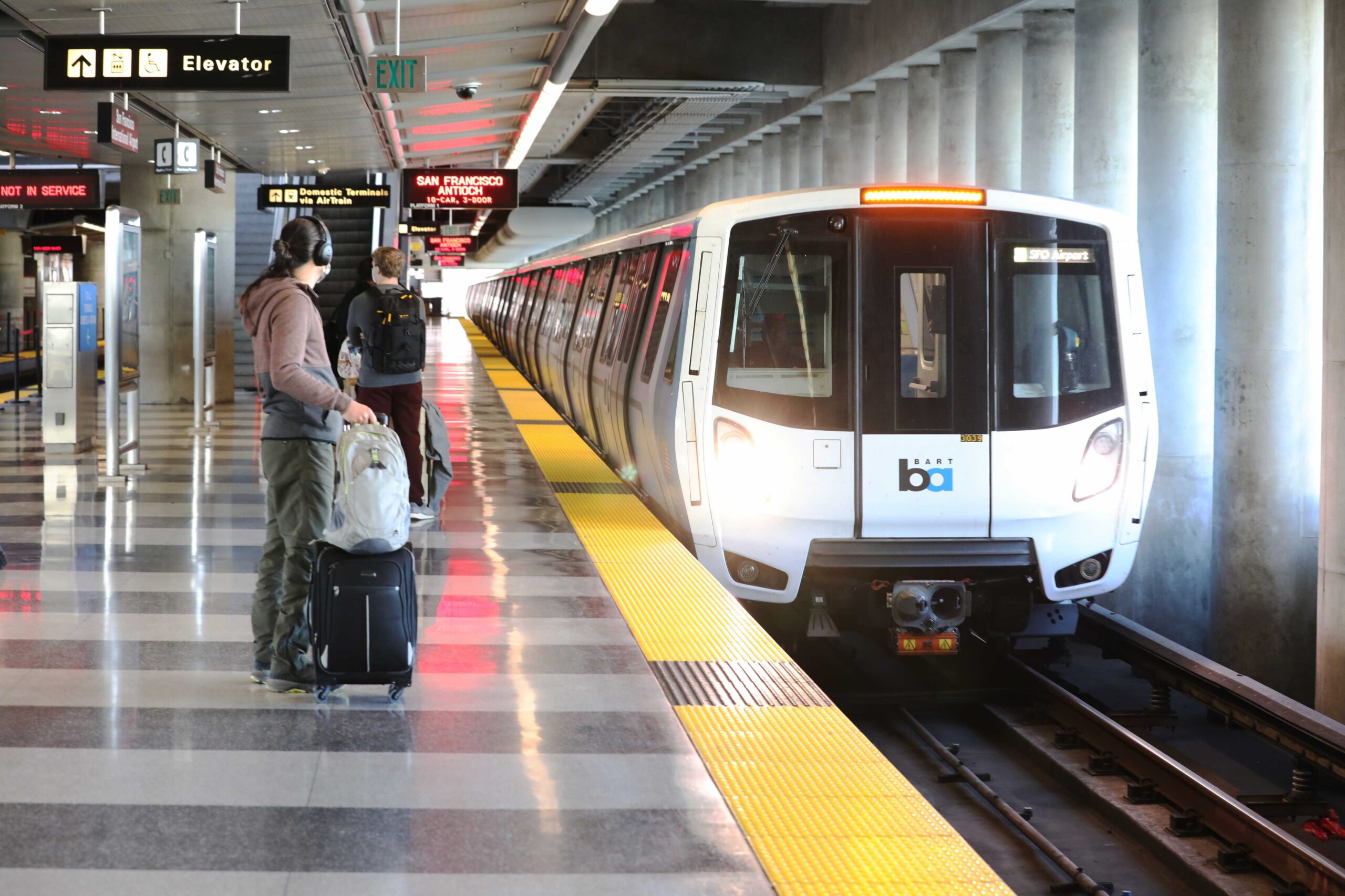Bay Area Rapid Transit (BART) established the Homeless Action Plan to address the state of homelessness on BART and across the Bay Area, and to allocate yearly funding towards connecting those experiencing homelessness with health resources and housing programs. The plan was announced in January 2023, the first of its kind in BART’s 50 year history.
In the last four years the number of people experiencing homelessness has increased by over 35%. As of January this year, on any given day there are about 38,100 Bay Area residents who are houseless, living outdoors or in places not meant for human habitation. As these numbers increase, more and more residents turn towards BART trains and stations as a temporary shelter.
Currently, BART serves five counties: Alameda, Contra Costa, San Francisco, San Mateo and Santa Clara, and runs approximately 410,000 trips daily on average with their 131 miles of track and 50 stations across the Bay. Across the Bay Area, BART has seven end-of-the-line stations which pose specific challenges related to enforcement, shelter and connection to services, as trains are cleared when they reach these stations. Below is a table that highlights some of the call data related to quality-of-life disturbances for end-of-the-line stations. On the very left is data on 5150(s), a section of the California Welfare and Institutions Code which allows adults experiencing mental health crises to be involuntarily detained in psychiatric hospitals for 72-hours when evaluated to be a danger to others or themselves.
Next to the 5150(s) data is information of the number of individuals using BART who receive welfare checks, and to the right is data outlining the number of people who use BART as an unauthorized dwelling, and those who have been caught trespassing.

photo courtesy of BART Homeless Action Plan
BART’s current response—active since May 2021—is primarily focused on building regional partnerships and developing internal capacity within the BART Police Department through the creation of a Progressive Policing and Community Engagement Bureau, and the hiring of Crisis Intervention Specialists (CIS) and Transit Ambassadors. The CIS serve as liaisons between BART Police and external community-based organizations that provide crisis intervention and mental health services, and also support individuals with finding housing services. Additionally, the CIS engage with BART personnel, the public and other stakeholders to establish an official presence and prevent disruptive behavior across BART stations. Consequently, the CIS aim to deter and diffuse acts of violence and vandalism through conflict resolution and other de-escalation practices. The Transit Ambassadors intend to create a highly visible uniformed presence across BART stations to assist patrons as needed and monitor activities in both stations and train cars during revenue service.
However, BART as an organization recognizes that these liaisons are no longer enough. BART understands the intense regional variation in numbers of those experiencing homelessness, and its dependence on where a station falls within the train line or a specific county. As a result, they have also concluded that there can’t be one quick fix to eliminating homelessness on BART.
Through their Homeless Action Plan, BART has developed an adjustable and customizable approach for each small station, major hub and end-of-the-line station to address each’s regional distinctions. Additionally, BART will continue to take stock of its resources and services in order to address regional gaps in services and spread equity towards locations that need a stronger focus.
Daniel Cooperman, BART’s Senior Manager of Social Services and the primary author of the Homeless Action Plan, called the proposal “a roadmap to addressing homelessness, mental health crises and substance abuse within our system [BART], and the larger Bay Area.”
Cooperman continued though, saying that as a transit system, BART’s primary focus has always been to run trains from point A to point B smoothly and safely for riders. However, given the state of the Bay Area, especially after the pandemic, Cooperman said the numbers of those experiencing homelessness is “too much to ignore.” The transit agency has long been used as shelters for safety by houseless individuals, but after the tremendous increase in homelessness throughout the COVID-19 pandemic, Cooperman explained that BART felt it was no longer something that could be put on the side. “It was something we wanted to put our foot in and really try to address the issues head on with the resources that we do have,” he said.

photo courtesy of Wiki Commons
The plan includes a myriad of long and short term goals and multi-step processes to achieve them; one of which being the end-of-the-line customizable plan. In addition to that particular project, the action plan categorizes its goals in four main strategies:
1) Expand BART’s resources. The transit system hopes to achieve this through refining the roles of its CIS and Transit Ambassadors in order to strengthen their one-on-one outreach and intervention. Furthermore, in expanding resources, BART intends to continuously evaluate their flexible fund programs and this year aims to explore the feasibility of developing long-term resources to support the needs of people experiencing homelessness on BART. This could include, but is not limited to, the creation of an associated 501 (c)(3) that would allow the newly created non-profit to apply directly for county and state resources to address homelessness (as public transit agencies are generally not able to apply for such resources).
2) Focus and work towards addressing root causes of homelessness. To do this, BART has organized a long term team to lead social impacts of BART, expanding the agency from simply a transit program, into a community impactor. As part of this sector, BART will continue to evaluate their means-based fare pilot program by offering a 20% discount per trip to adult riders aged 19-64 whose household incomes are no more than twice the federal poverty level. Moreover, BART also plans to break ground on new construction to create more affordable temporary and permanent housing on BART property.
3) Center BART as a regional convenor of homelessness on public transit. BART is unique in the fact that it serves five total counties, each with differing numbers of homelessness. Consequently, with the creation of this action plan, BART seeks to form multijurisdictional networks and partnerships, and also aims to lead homelessness efforts around a national transit coalition which will provide needed advocacy at the federal, state and regional levels.
4) Address regional variation. As previously mentioned, the formation of this plan has also created a specially tailored plan to address varying levels of homelessness in different counties, in order to provide the most equitable support for those experiencing homelessness across the Bay Area.
In order to track the plan’s improvement and achievements over time, BART has outlined the following metrics and goals which the agency hopes to accomplish annually.

photo courtesy of BART Homeless Action Plan
As the plan begins to be put into effect across the Bay Area, BART recognizes that it cannot ultimately end homelessness. Instead, they hope to gradually make improvements within its systems and the broader Bay Area through focusing on measurements of success, not solely based on reducing the numbers of people experiencing homelessness, but instead on reducing the corresponding quality-of-life issues and increasing the service connections and housing opportunities.







рабочий промокод 1хбет https://tiross.com/classes/pgs/?promokod_260.html